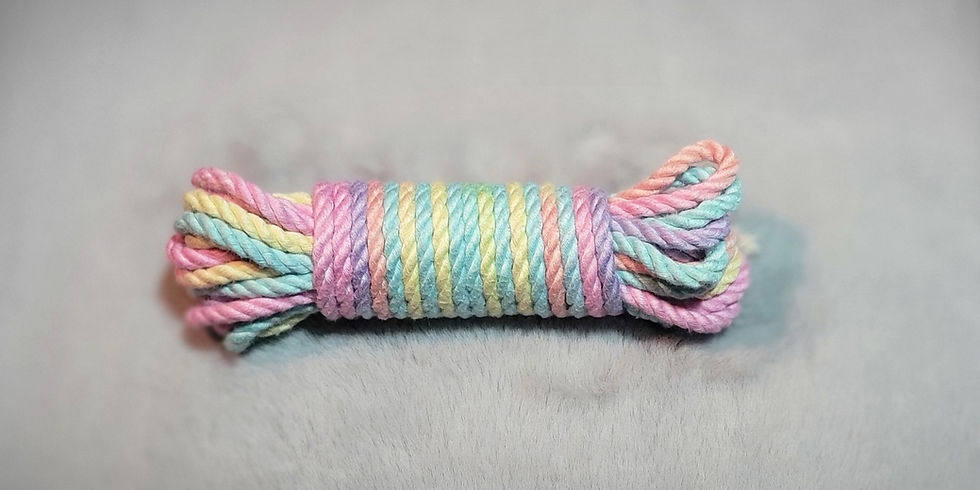
The Hidden Healing: How Shibari Can Transform Your Mental Health
- Joshua Thomas
- Jan 5
- 4 min read
Shibari is often seen as a beautiful and intricate art form, admired for its aesthetic appeal and the skill required to create its elaborate designs. However, its benefits extend far beyond what meets the eye. Shibari is a deeply mindful and intentional practice that can offer surprising ways to enhance mental health. Whether you are tying, being tied, or exploring self-ties, this practice can transform how you connect with yourself and others, fostering emotional healing, self-awareness, and personal growth in unexpected ways.
One of the most profound and immediate benefits of shibari is its ability to enhance mindfulness. In today’s world, where distractions are constant and stress levels run high, finding ways to ground yourself in the present moment is essential for mental well-being. Shibari requires a singular focus on the here and now. Every knot, loop, and pull of the rope demands your full attention, creating a meditative state that quiets the noise of daily life. This sense of mindfulness is not just about tying; it’s about being fully present with the sensations of the rope, the rhythm of your movements, and the connection between yourself and your partner or yourself and the art you are creating.
The tactile sensations of the rope against your skin, combined with the rhythmic nature of tying, help you enter a state of flow. This state of flow, often associated with activities like yoga or tai chi, allows you to let go of intrusive thoughts and immerse yourself fully in the process. Over time, practicing this mindfulness through shibari can reduce stress, calm an overactive mind, and provide a valuable tool for managing anxiety. Even a simple practice, such as creating a single-column tie, can help anchor you in the moment and provide a sense of calm that resonates throughout your day.
Shibari also offers a powerful opportunity to build trust and deepen emotional connections, particularly when practiced with a partner. The act of tying or being tied is an inherently vulnerable experience, requiring open communication, consent, and a willingness to trust one another. These elements create a shared space where both partners can feel safe to express themselves, explore boundaries, and connect on a deeper level.
The emotional intimacy that develops through shibari is profound. By engaging in this practice together, partners build a foundation of trust that transcends words. This experience can help foster better communication, strengthen bonds, and even alleviate feelings of anxiety or insecurity within the relationship. For many, shibari becomes a way to cultivate emotional closeness while simultaneously learning to respect each other’s limits and boundaries, creating a supportive and empowering dynamic.
Beyond its relational benefits, shibari is a form of self-expression and creativity that can be deeply therapeutic. At its core, shibari is an art form. The intricate patterns and designs created with the ropes allow you to explore and express your emotions in a way that is both visual and tactile. Creativity has long been recognized as a tool for mental health, providing an outlet for processing complex feelings and finding clarity. Shibari adds an additional layer to this process, allowing you to engage your body and mind simultaneously in a dance of art and emotion.
Whether you are crafting decorative knots, experimenting with self-ties, or working with a partner, shibari can become a mirror for your inner state. Each tie, pattern, and choice of rope reflects your emotions, thoughts, and intentions, offering a unique form of non-verbal communication and self-discovery. This creative process not only provides a sense of accomplishment but also opens the door to greater emotional freedom and understanding.
Another unexpected way that shibari can support mental health is by promoting body awareness and fostering a positive self-image. In a world where many struggle with body insecurities or feelings of disconnection from their physical selves, shibari provides a unique opportunity to reframe how you view your body. By using your body as a canvas for rope art, you begin to appreciate it in a new and empowering way.
Rather than focusing on perceived flaws, shibari encourages you to see the beauty in your form and the artistry of the shapes and patterns created. For many, this shift in perspective is transformative, fostering self-compassion and a deeper connection to their physical selves. The tactile sensations of the rope, combined with the visual appeal of the designs, help you embrace your individuality and celebrate your body as it is. This newfound appreciation can combat negative self-talk and replace it with a sense of empowerment and pride.
Finally, shibari can serve as a profound method for emotional release and stress reduction. The act of binding and releasing, whether it is physical, symbolic, or both, offers a cathartic experience that allows you to let go of pent-up tension and emotions. For some, the sensation of being tied provides a comforting cocoon-like experience, evoking feelings of safety and relaxation. For others, the repetitive movements of tying create a soothing rhythm that calms the mind and provides a sense of order and control.
This physical and emotional focus can help unlock a sense of relief and relaxation, similar to the benefits provided by other somatic therapies that connect the body and mind. By engaging in shibari with intention, you create a safe space to explore and release emotions, reduce stress, and foster a sense of balance and well-being.
Ultimately, shibari is much more than an art form. It is a journey into mindfulness, connection, and healing that can transform your relationship with yourself and others. Whether you are looking for a way to reduce stress, enhance creativity, or deepen emotional intimacy, shibari offers a unique and powerful path to better mental health. If you are ready to explore the art of connection and discover how shibari can enrich your life, Bound by Elegance Shibari is here to guide you every step of the way.



Comments